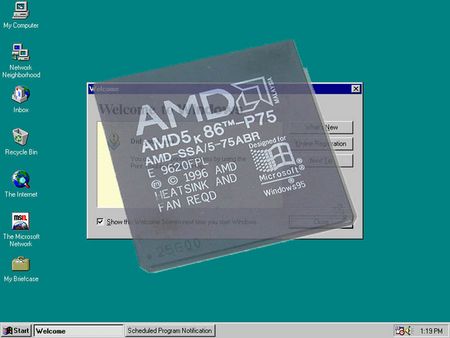Imitation To Innovation: AMD's Best CPUs
The K5: AMD's Very Own Processor
In 1996, AMD released its fifth-generation processor, the K5. Compared to Intel’s Pentium, the K5 was technically more advanced, though it did have some faults. It’s especially interesting because of its RISC-based internal architecture that decoded x86 instructions into micro-instructions before executing them. The K5 had difficulty reaching high clock speeds and its FPU was a little weak. Still, in normal use, the K5 was a better performer than the Pentium and its PR was not just hype—a K5 clocked at 100 MHz was sold as a PR133 chip, meaning that AMD considered it as being equivalent in performance to a 133 MHz Pentium.
| Code name | SSA/5, 5k86 |
| Date released | 1996 |
| Architecture | 32-bits |
| Data bus | 64-bits |
| Address bus | 32-bits |
| Maximum memory | 4,096 MB |
| L1 cache | 16 KB + 8 KB |
| L2 cache | motherboard (FSB frequency) |
| Clock frequency | 75-133 MHz (PR75 - PR200) |
| FSB | 50-66 MHz |
| FPU | built-in |
| SIMD | no |
| Fabrication process | 500 - 350 nm |
| Number of transistors | 4.3 million |
| Power consumption | 11-16 W |
| Voltage | 3.52 V |
| Die surface area | 251 - 181 mm² |
| Connector | Socket 5 or 7 |
The use of the PR resulted in such oddities as a K5 PR90 and PR120 running at the same frequency (90 MHz) and a PR100 and PR133 both clocked at 100 MHz. Notice also that the CPU package informed buyers that a heat sink and fan were required—at that time, the use of such cooling devices was not yet common practice.
Get Tom's Hardware's best news and in-depth reviews, straight to your inbox.
Current page: The K5: AMD's Very Own Processor
Prev Page Am486: The Last Clone Next Page The K6: AMD Extends Its Range-
cpuTweaker Lackluster article...a lot of backround on the chips were left out, fact that make thier acomplishments truely impressive. To THG's credit, their was at least some mention of the impact Alpha had on some of the chip designs, but no where near being complete.Reply
Where the intel article seemed to overshadow intel's little victories, this article seems to gloss over AMD innovation (though i'll admit that i didn't recall the bit about the Intel chip, either the pentium or pentium pro, that gave incorrect values for mathmatical equations)
Both articles really need alot more detail added. As i've actually ranted about the history i'm reffering to in the comments section of the intel article as well as many other's i won't re-hash it. -
neiroatopelcc Despite not being terribly detailed, I still like these recaps. Good articles really, all of them. Now all we need is one on alpha, and on how the mac stuff went before it was called intelReply -
neiroatopelcc Oh and on ati I suppose, seeing we've already had nvidia :9 ... or even matrox, 3dfx and others that have vanished in a combo article...Reply
This is like viasat history - only more specific and technical -
AMD 386 SX @25 MHz was powering my first personal computer. The whole computer costed ~4000$ and it wasn't even top performance.Reply
AMD 486 @120 Mhz was making my friends that bought an early Pentium red with envy.
-
jj463rd I had several systems with the AMD 486 X5 processor at 133 Mhz.I also have 2 K6-2 systems,1 Athlon a Athlon 64 and a Phenom X4 9850 BE system.Actually most of my systems are Intel basedthough.When I first heard that AMD was in pretty big trouble I still wouldn't get a B2 Phenom but when they fixed the bug I decided to help them out by building the Phenom X4 9850BE system which runs very well.Plus I've just ordered some new ATI graphics cards too.Reply
Someone gave me a AMD K5 system.
Thanks for the article. -
Malovane Heh, owned one AMD processor of every line, starting with the 8086 and ending with the Phenom. Wasn't even intentional for the first decade, but I'm glad I did. Liked the article, though it could have gone into a bit more detail and back story.Reply -
Minerva I enjoy these articles as well, as I collect old hardware...Reply
I have quite a few chips from both makers, including the AMD 40MHz 386, and an Intel 386 & 387 33MHz cpu's, which are quite scarce... -
NightLight I too collect old hardware Minerva, in fact, I still have a lot of them still in running order on a mainboard ! Good Review, I just loved to see that windows 3 series again :)Altough a little bit biased...Reply
